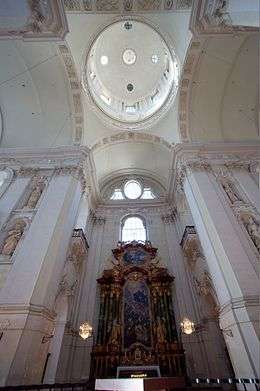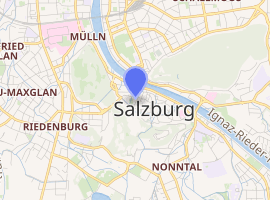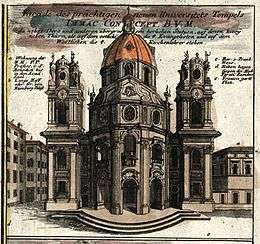Kollegienkirche, Salzburg
The Kollegienkirche (Collegiate Church) in Salzburg, Austria, is the church of the University of Salzburg. It was built in Baroque style by Johann Bernhard Fischer von Erlach. Dedicated to the Immaculate Conception, it is part of the UNESCO World Heritage Site Historic Centre of Salzburg. It is now both the parish church of people connected to the university and a venue of the Salzburg Festival.
| Kollegienkirche Collegiate Church | |
|---|---|
 Main vault and a side altar | |

| |
| 47.7991°N 13.0431°E | |
| Location | Salzburg |
| Country | Austria |
| Denomination | Catholic |
| Website | www |
| History | |
| Dedication | Immaculate Conception |
| Architecture | |
| Functional status |
|
| Style | Baroque |
| Completed | 1707 |
| Administration | |
| Parish | Universitätspfarrsprengel |
| Diocese | Salzburg |
| Official name | Historic Centre of Salzburg |
| Type | Cultural |
| Region | Europe and North America |
History
The building is the church of the University of Salzburg, located at the Universitätsplatz (University square). Bishop Paris von Lodron planned a university church on the location of the former Frauengarten, instead of using the Aula (main auditorium) for church services of the university.[1][2] While two successors were not able to realise the plan, Johann Ernst von Thun succeeded as part of his plan to develop Salzburg in Baroque style. The building by Johann Bernhard Fischer von Erlach was begun in 1694.[3] In 1707, it was dedicated to the Immaculate Conception, which is celebrated on 8 December, a national holiday in Austria.[2] It is believed that Mozart's Missa brevis in D Minor, K. 65, was commissioned by the church and premiered on 4 February 1769.[4]
During the occupation by Napoleon, the church was used as storage. After the university was dissolved, it served as a garrison church. In 1922, the Salzburg Festival performed there the premiere of Hugo von Hofmannsthal's Das Salzburger große Welttheater, directed by Max Reinhardt.[3][5] In 1969, Emilio de' Cavalieri's Rappresentatione di Anima, et di Corpo was presented in an arrangement by Bernhard Paumgartner. The church has been a regular venue of the festival since the 1970s. In 2008, Salvatore Sciarrino's opera Luci mie traditrici was staged by Rebecca Horn.[3]
The church was returned to its original status as a university church in 1964. On 18 May 2008, it was designated the parish church for a parish named Universitätspfarrsprengel, serving people connected to the university.[6] The building has been restored in the 21st century, beginning with the apse, which was completed in 2010.[7] Most of the other restoration was completed in 2013.
The church is a listed monument and part of the UNESCO World Heritage Site Historic Centre of Salzburg.
Architecture
The church is a main work of Fischer von Erlach. He designed a hall with white walls without paintings which became a model for late-baroque churches in southern Germany.[7][1]
The organ was built in 1866 to 1868 by Matthäus Mauracher, an instrument of 34 stops on three manuals and pedal.[8] Anton Bruckner played the organ several times.[9] The organ was restored in 1982 by Orgelbau Pirchner.[10]
Literature
- Alice Schulte: Die Kollegienkirche in Salzburg. Eine impressionistische Studie. In: Mitteilungen der Gesellschaft für Salzburger Landeskunde 57, Salzburg 1917, p. 1–12.
- Felicitas Hagen-Dempf: Die Kollegienkirche in Salzburg. Wien 1949.
Gallery
 The facade, circa 1712
The facade, circa 1712- The facade of the church at night
 A side of the church
A side of the church The Matthäus Mauracher organ
The Matthäus Mauracher organ
References
- Kollegienkirche – Collegiate Church Salzburg
- Personalstand der Welt- und Ordens-Geistlichkeit der Erzdiözese Salzburg für das Jahr 1957 (Schematismus 1957), Erzbischöfliches Ordinariat Salzburg 1957, p. 154.
- Kollegienkirche Archived 2013-05-05 at the Wayback Machine, Salzburger Festspiele → Spielstätten
- Baur, Eva Gesine (2005). "1. Akt, 4. Szene". Mozarts Salzburg: auf den Spuren des Genies (in German). C. H. Beck. pp. 38–44. ISBN 9783406535291.
- "Das Salzburger große Welttheater" (in German). austria-forum.org. Retrieved 6 June 2017.
- Pfarre Salzburg-Universitätspfarre, Pfarrverzeichnis Erzdiözese Salzburg, kirchen.net
- Ein Juwel von Weltrang – Festakt und Benefizkonzert in der Salzburger Kollegienkirche. Fertigstellung der Apsis als wichtige Etappe der Innenrestaurierung. Bundesdenkmalamt, retrieved 2 February 2013
- Orgel Salzburg, Kollegienkirche Archived 2012-04-17 at the Wayback Machine orgelsite.nl
- Salzburger Volksblatt 7 April 1869 and 9 September 1870. In: Gerhard Walterskirchen: Baugeschichte der Orgel der Universitätskirche. In: Die Orgel der Universitätskirche Salzburg. Weihe der renovierten Mauracher-Orgel 10. Juli 1982, p. 18f.
- Johann Pirchner: Die Restaurierung der Mauracher-Orgel in der Universitätskirche Salzburg. In: Die Orgel der Universitätskirche Salzburg. Consecration of the restored Mauracher Organ 10 July 1982, p. 29.
External links
| Wikimedia Commons has media related to Kollegienkirche, Salzburg. |